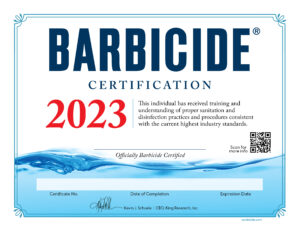“Most salons were doing infection control properly before COVID and their adherence to safety guidelines has meant they are not a part of most second wave shutdowns.”
Q: I am considering using a service that sprays down my entire salon and kills bacteria for 3 months – what do you think?
L: This is a question I have been getting a lot lately and funny enough, many of these products have been around for a while, they have just been “re-introduced” during the current pandemic. While it may seem like a simple, albeit costly, solution to get away from the time consumed between each client, it may not be that simple. All states had rules in place prior to the pandemic about what needed to be cleaned and disinfected before each use in the salon. The key here is that the state requires infection control (cleaning & disinfection) to be done between clients and they do not allow for it to be done every 3 months. This would not only apply to multi-use implements, but also to items such as pedicure and shampoo bowls. Basically, anything that comes into contact with the client, or even you, must be cleaned and disinfected prior to each use. In addition to states requiring that non-porous items be disinfected prior to use, they also require that the disinfectant be effective against bacteria, viruses and fungi. While many of these sprays do kill bacteria and viruses in the first hour or so, the ongoing efficacy (beyond the first couple hours) is only for bacteria. In fact, there are very few of these products that make any fungal claim at all and, if they do, it is only for the first hour. Given that these are standard requirements in the cosmetology rules of most states, these types of sprays would not meet that criteria.
That said, many of the larger surfaces that you now want to clean and disinfect or are required to by a temporary guideline aren’t specifically addressed in the existing rules or new guidelines. In this case, we are talking about things like stations, chairs, back bars, reception desks, etc. which, while they make people nervous, are not likely sources of spread for things like COVID 19. In fact, these types of surfaces are far better transmission reservoirs for bacteria and fungi. In addition, some of the surfaces that would be sprayed will be soft surfaces such as your station chairs that are often covered in vinyl and couches in waiting areas. These surfaces are not designed for harsh disinfectants or any chemical applications, so that must be taken into consideration. Remember, disinfection is for hard, nonporous surfaces such as glass, metal and plastic and really nothing else.
Finally, these spray applications are costly and with the ability to have 3 months of efficacy against bacteria, it is wise to consider the health and environmental implications of this as a supplement to what you were already doing in the salon. Most salons were doing infection control properly before COVID and their adherence to safety guidelines has meant they are not a part of most second wave shutdowns. By doing what you were doing before and being stringent about doing it properly, you can save yourself the cost of these sprays that likely don’t add to the safety of a service in your salon and may even damage some of your surfaces. Remember the following:
- Hard, nonporous implements and surfaces should be cleaned and disinfected prior to each use. These are typically items made of glass, metal or plastic.
- Soft, porous surfaces can be cleaned, but not disinfected.
- Disinfectants must be EPA registered and effective against bacteria, viruses and fungi.
- Disinfectants must be properly mixed and made fresh daily.
- The contact time for disinfectants must always be strictly adhered to for proper infection control.
You learned proper infection control in school and I encourage you to rely upon that knowledge… it is an old science, but it still works!

